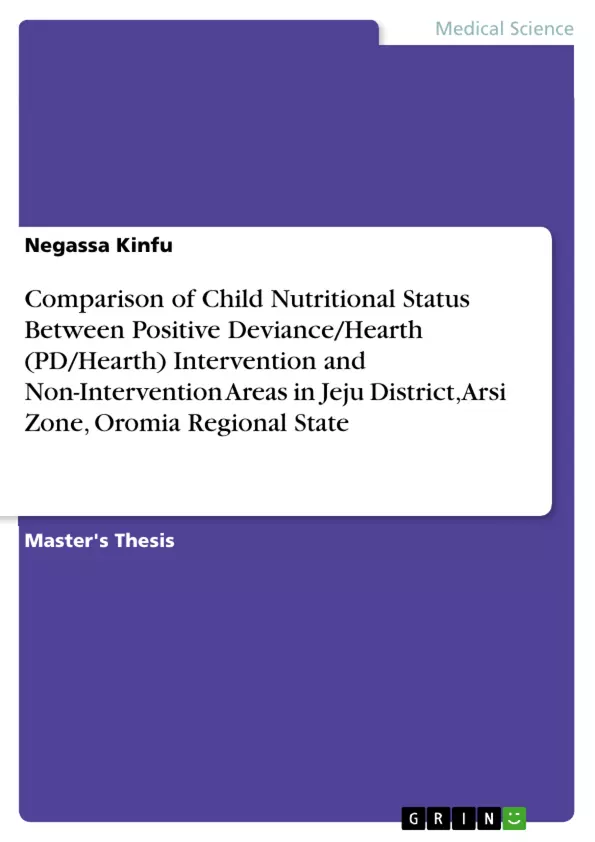World Vision Ethiopia had implemented a two years Essential Nutrition Promotion (ENP) Project, using the Positive Deviance/Hearth (PD Hearth) approach, in two Kebeles of Jeju District from June 2007 to September 2009. The PD Hearth approach identifies those behaviors practiced by the mothers or caretakers of well-nourished children from poor families and transfers such positive practices to others in the community with malnourished children. The study investigated whether there are improvements sustained three years after the program was terminated. A Cross-sectional survey was administered to a total of 249 children, 123 of them randomly selected from two Kebeles that had previously participated in the program and 126 children from a neighboring comparison two Kebeles. All the sample children 6-59 months of age were measured, and mothers of children under 24 months interviewed. The children born after the completion of the program in the intervention area were significantly better nourished than those in the comparison area, with adjusted mean weight-for-age Z scores of -0.963 versus -1.308 (p < 0.05), respectively. More intervention area mothers of under 24 months children were currently breastfeeding, at the time (100%) as compared with comparison area mothers (94.2%, p < 0.05). Frequency of complementary feeding to the 6-24 months children was better among the intervention area mothers as compared to their counterparts, 4.24 versus 3.83 per day, respectively (p < 0.05). Intervention area mothers reported that they often washed their hands before feeding their children (97.6% vs. 89.4%, p < 0.05). More intervention area mothers (97.0%) also reported that their family members use pit latrines rather than open defecation as compared to the comparison families (89.3%) (p < 0.05). The PD behaviors practiced through the hearth sessions might have sustained years after program completion, and might have contributed to better nutritional status of the children.
Inhaltsverzeichnis (Table of Contents)
- DEDICATION
- ACKNOWLEDGEMENT
- ABBREVIATIONS
- LIST OF TABLES
- LIST OF FIGURES
- ABSTRACT
- INTRODUCTION
- Background
- Statement of the Problem
- Objectives
- General Objective
- Specific Objectives
- Research Questions
- Significance of the Study
- REVIEW OF LITERATURE
- Undernutrition
- Stunting
- Wasting
- Underweight
- Causes of Malnutrition
- Interventions to Improve Child Nutrition
- Positive Deviance/HEARTH Approach
- Previous Studies on PD/HEARTH Intervention
- MATERIALS AND METHODS
- Study Design
- Study Area
- Study Population
- Sampling Procedure
- Data Collection
- Socio-demographic Characteristics
- Anthropometric Measurement
- Dietary Diversity Score
- Household Food Security
- Health Status
- Data Analysis
- RESULTS
- Socio-demographic Characteristics of Mothers and their Children
- Nutritional Status of Children
- Stunting
- Wasting
- Underweight
- Factors Associated with Child Nutritional Status
- DISCUSSION
- CONCLUSION
- RECOMMENDATIONS
- REFERENCES
- APPENDICES
Zielsetzung und Themenschwerpunkte (Objectives and Key Themes)
This MSc thesis aims to assess the impact of the Positive Deviance/HEARTH (PD/HEARTH) intervention program on child nutritional status in the Jeju District, Arsi Zone, Oromia Regional State, Ethiopia. The study examines the differences in nutritional status between children in areas with and without PD/HEARTH intervention. The key themes explored in this thesis include:- The prevalence and determinants of child malnutrition, particularly stunting, wasting, and underweight, in the study area.
- The effectiveness of the PD/HEARTH intervention in improving child nutritional status.
- The factors associated with child nutritional status, including socioeconomic, demographic, dietary, and health-related factors.
- The potential benefits and limitations of the PD/HEARTH intervention program for improving child nutrition in resource-limited settings.
- Recommendations for enhancing the implementation and effectiveness of nutrition interventions to address the challenges of child malnutrition.
Zusammenfassung der Kapitel (Chapter Summaries)
- Introduction: The introduction provides the background on the global burden of child malnutrition, highlighting the prevalence and consequences of stunting, wasting, and underweight in Ethiopia. It outlines the specific problem addressed by the study, which is the impact of the PD/HEARTH intervention on child nutritional status. The study's objectives, research questions, and significance are also presented.
- Review of Literature: This chapter delves into the existing literature on undernutrition, its causes, and various interventions, including the PD/HEARTH approach. It examines previous studies investigating the effectiveness of PD/HEARTH interventions in improving child nutrition.
- Materials and Methods: This section details the study design, the study area, the population, sampling procedure, data collection methods, and data analysis techniques. It describes the specific measures used to collect socio-demographic data, anthropometric measurements, dietary diversity scores, household food security information, and health status indicators.
- Results: The results chapter presents the findings of the study. It provides a detailed analysis of the socio-demographic characteristics of the mothers and their children, the nutritional status of the children (stunting, wasting, underweight), and the factors associated with child nutritional status.
- Discussion: This chapter interprets the findings in light of existing literature and explores the implications of the study results for understanding child nutrition in the study area. It discusses the effectiveness of the PD/HEARTH intervention, the factors influencing child nutritional status, and the challenges and opportunities for improving child nutrition in similar contexts.
Schlüsselwörter (Keywords)
This research focuses on child malnutrition, particularly stunting, wasting, and underweight, in the context of the Positive Deviance/HEARTH intervention in Ethiopia. The study investigates the effectiveness of this intervention, explores associated factors influencing child nutritional status, and provides recommendations for improving child nutrition outcomes. Key terms include: child malnutrition, stunting, wasting, underweight, Positive Deviance/HEARTH intervention, Ethiopia, nutritional status, socioeconomic factors, dietary diversity, health status, interventions.- Quote paper
- Negassa Kinfu (Author), 2013, Comparison of Child Nutritional Status Between Positive Deviance/Hearth (PD/Hearth) Intervention and Non-Intervention Areas in Jeju District, Arsi Zone, Oromia Regional State, Munich, GRIN Verlag, https://www.grin.com/document/299040



